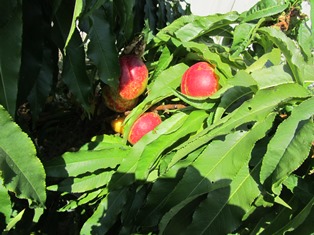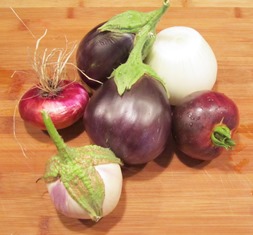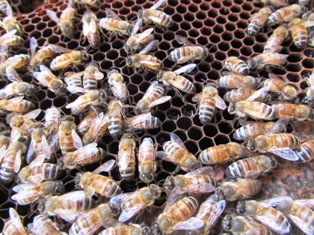Archive for the 'Pests' Category
Remind Me Again, What Good Are Gophers?

Cecile Brunner forms an arch over a statue of the Virgin Mary in one of the prettiest and most peaceful areas of my garden
The lovely Cecile Brunner rose that serves as the anchor for a small meditation garden on the northwest side of my little farmhouse suddenly appears yellowed, leafless, and lifeless. Honest to goodness, she looks like she’s croaked. It’s certainly a strange turn of events, since she had numerous new canes and the leaves were shiny and healthy only a week ago.
There is a small eruption of new dirt nearby–suggestive of moles (insect eaters) and gophers (vegetarians) and maybe voles–(voles eat roots but don’t leave mounds). So my rose problem might actually be two-fold–either way–it’s underground.
I could dig and back fill those tunnels with dirt and maybe I should. I’ve heard you can break a leg stepping into a gopher hole and I’m not talking livestock here. I wonder if the vole and gopher are sharing a network of tunnels down there dead-ending in the gopher’s bunker.
I gave the poor rose a big drink of water as soon as I discovered her condition, not knowing what else to do. As I stood there, watering with hose in hand, I saw the earth around the rose’s root cave in. Seriously?
So I’m thinking there must be a one heck of a big tunnel. This is war! I decide to stick the hose right into the tunnel and fill it with as much water as that hole will hold . . . and then some.
Strangely, while I’m dealing with the rose problem, I look past the fresh dirt mound and notice that one of the Dutch purple irises in a bed of a hundred or more has broken into full bloom. What gives? Those beauties normally bloom around Easter. I wonder why the voles haven’t attacked the rhizomes of the irises.
The condition of the Cecile Brunner climbing rose breaks my heart. Maybe she’ll spring back to life to bloom again next spring. For now, I’ll clip the beautiful iris and tuck it into a vase with some roses from other bushes on the farmette. That done, I’ll put an all-out effort into finding out how to get rid of those underground buck-tooth bandits . . . for good. Feel free to leave me your ideas. I’ve tried almost everything I’ve read on the Internet.
An Unwelcome Visitor for Brunch
I welcome visits into my yard by honey bees–they are not interested in me or my plate of food (unless it has honey on it), but hornets, wasps, and yellow jackets are not welcome.
This past Sunday morning, I was enjoying a plate of food on my patio when a yellow jacket made an unwelcome appearance. These are the yellow and black predatory wasps you find on your soda cans and sweets at picnics. Some people call them “meat bees” but they are actually wasps.
What value are they to gardens, you might wonder. I did. Although I loathe them, I did a little research and discovered that yellow jackets are predators of insects that many of us gardeners consider pests. But try as I might, I just can’t make myself like yellow jackets. The females don’t just sting and die. They can sting multiple times. And wasp stings hurt.
About those stingers–they are like lances with barbs, injecting venom into you during a sting. The stings are not dangerous unless you happen to be stung repeatedly or you are allergic to bee and wasp stings. In that case, you might carry a epinephrine autoinjector (known as an EpiPen) in the event of a life-threatening sting to treat anaphylaxis.
Keep a lookout for yellow jackets in the spring when the queen seeks a place to construct a paper nest. These wasps (related to hornets) live in social colonies with female queens and workers, and also males, known as drones. They like to establish their nests in hollowed logs and human structures (like houses with holes for entry into attics or walls). They enjoy a diet rich in sugar and carbohydrates. Don’t we all? But take care when enjoying your al fresco Sunday brunch. You never know who might drop in!
Could the Weird Weather Be Affecting Our Crops?

Nectarines are ripening but the tree recently developed peach leaf curl, noticeable in the top right leaves
Since the beginning of the agrarian age, farmers have understood that weather affects crops. To say the weather this year–at least in Northern California–has been weird is an understatement. I can’t help thinking it’s impacting my garden.
In the last three weeks, my healthy nectarine trees developed that dreaded fungal peach leaf curl, despite the prescribe spraying throughout the dormant season with horticultural oil. I’ve got tomato vines spreading everywhere with few tomatoes. The corn developed such a terrible infestation of corn aphids that I pulled out all the corn and fed it to the chickens.
I’m not blaming the weather for my all garden woes, but it’s got to be a factor in what my neighbors and I are witnessing in our gardens and orchards with regard to less bountiful crops.
We have to water because the soil is so dry it’s cracking open. We have to stay on top of pest infestations as we all grow organic and the bees travel through all of our backyards and up to five miles or so. We share our produce and stories of what’s happening in our gardens so we can deal with the problems.
We had very little rain during our rainy season and now local reservoirs are low. For the last three days, the Bay Area has had over 11,000 dry lightning strikes (putting fire departments on high alert), temperatures inching toward triple digits, and high particulate in the air because of all the wildfires burning in our state and elsewhere in the West.
I heard a recent newscaster using that dreaded word “drought” and lamenting about the low level of water currently available for farmers to use for their crops and orchards, especially in the California’s Central Valley, an area considered an important “bread basket” of the United States. The good news is that those farmers will be winding down their water usage as fall approaches and crops are harvested.
As the weather goes, so do the crops–something farmers and gardeners have always understood. My garden woes likely have a lot to do with the head gardener–that’s me. But I’ve been gardening here for four years and this year’s garden has been the least bountiful. While there are many factors to evaluate, the weird weather has to be considered.
Skunks Snacking on Bees, Who Knew?
I had to do some searching around the Internet to beekeeping sites to find out whether or not skunks eat bees. Apparently they do.
The way it works, a skunk comes around in the early evening after sundown and will scratch on a hive until the guard bee or bees come straight out and then swats at them before eating the bees. Mother skunks even teach this behavior to their young.
My beekeeper neighbor keeps his hives elevated onto a bottom board platform. One would think this should ensure that the skunks would not bother the hive, but there is evidence lately of a skunk coming around.
Some of the telltale signs that a skunk might be raiding your hives are scratch marks on the hive, muddy prints if there’s a water source nearby, skunk feces (some may have dead bees in it), and dead bees on the ground in front of the hive.
When marauding mammals like skunks and raccoons get a taste for bees, a hive can die. Some suggestions I found searching around on the Internet include putting down tack strips (like those used to install wall-to-wall carpets).
Another is to put a screen around the hives (with an opening at the top for the bees to come and go) or place chicken wire in front of the hives. Skunks like standing on solid footing, not wire or mesh. A roll of mesh at the base of the hive could also be an effective deterrent.
You definitely want to get rid of the skunks. One can decimate a hive in a single night scratching, eating, throwing dirt until the bees get angry and come out in mass and then the skunk has a big meal. The hive thus weakened can be empty within a day or so.
Moles and More
Fresh mounds of dirt and surface runways have newly populated the rear of the Henny Penny Farmette. I recognize the dirt mounds as telltale signs of the presence of either moles, gophers, or voles.
Since the mounds are small and shaped like volcanoes with ridges on the soil surface, my best guess is that my night visitors are moles–mammals that live underground and create a vast network of tunnels.
Of the three, moles are actually the more preferable since they do not go after plants and bulbs. As insectivores, they eat earthworms and grubs. If you have a flower beds and a lawn, that’s a perfect place for them to find food . . . and they need a lot. By some estimates, they need to eat their body weight daily.
There are ways to detect which little creature you have in your lawn. Moles leave fresh dirt mounds piled like volcanoes. Moles leave subterranean pathways that pop up the soil to look like ridges.
Voles leave no mounds. Pocket gophers leave a horseshoe-shaped mounds of dirt.
Which brings me back to the much maligned mole. Whereas voles are voracious root eaters, moles actually can be beneficial to a garden, eating worms, bugs, and grubs but they don’t eat plants or bulbs. They will starve if fed a diet of only plants. See, http://www.ipm.ucdavis.edu/PMG/PESTNOTES/pn74115.html
Their shallow tunnels aerate the garden soil. And if you find the eruptions unsightly, you simply have to tamp down the raised areas. Scientists have studied methods of getting rid of moles and say none of the home remedies (castor oil, shattered glass, chewing gum, etc.) really works. That’s not to say they can’t be banished; it’s just difficult to find a humane way to do it.
If we gardeners can’t get rid of them humanely, perhaps we could just learn to live with them. Another option is to attract barn owls to your property, since they love dining on moles, gophers, rats, mice, and other rodents. If you build a barn owl nest, they might take up residence. Mother Nature’s eco-control is always best. See, ftp://ftp-fc.sc.egov.usda.gov/CA/news/Publications/wild_habitat/owl_nest.pdf
Harvesting and Saving Sunflower Seed for Replanting
Last year, my sunflowers were gigantic and gorgeous. I removed heads as large as dinner plates for drying so I could plant the seeds again this year. Some of the smaller heads contained seeds that were totally black. I figured the bees had done some magic with cross pollination of other sunflowers from the neighborhood.
I stored the heads in my garden shed over the winter, but never got around to removing the seed for replanting. When I went into the shed to retrieve them for planting last month, I discovered with dismay that something had devoured most of the seeds. A few seeds were left so I optimistically tucked them into the ground. Alas, none germinated.
Determined not to let that ever happen again, I recently bought four packets of open-pollinated, heirloom sunflower seed. After they grow, I’ll harvest and preserve the seed correctly at the end of summer so I’ll have plenty to plant next year. When you use open-pollinated, heirloom seed, next year’s plants will come true to the characteristics of the parent. This is not the case, however, with hybrid seed.
In case you might be interested in harvesting and storing sunflower seeds, too, here are the steps.
1. When the sunflower heads have turned from green to brown, remove the head from the stalk with a knife.
2. Let the head dry for a few weeks to a month in a dry place, safe from marauding squirrels and racoons. You can tie the heads with string and hang them from the ceiling in a drying shed or place them on paper.
3. Shake or gently bang or otherwise extract the seed onto paper from the dried heads.
4. Store the seed in paper envelopes and label them with the date and type of seed.
Stinking Away Gophers
In anticipation of the city-wide garage sale this weekend, I’ve been walking around the property, looking for things to sell and making a to-do list. That is, until my foot disappeared into a freshly dug tunnel. Now all I can think about is how to get rid of the gophers.
A newly erupted, fan-shaped mound of dirt with a hole off to the side suggested a gopher had been tunneling underground in my yard. How do I know it’s a gopher and not a mole? The fan-shape ridge of soil and complete disappearance of plants are telltale signs of the presence of a gopher.
Moles tunnel but don’t consume plants. They feed on grubs and worms. Their soil ridges are shallow and near the surface.
Frankly, I don’t mind the moles as much as the gophers. Moles are harmless and their tunnels, although ugly, aerate the soil. But gophers are destructive. In the last two weeks, I have witnessed how a gopher can take down a lush garden. A number of organic plants, tomatoes, cilantro (young leafy coriander), and hot peppers that were planted last month have been decimated in less than a week by gophers.
I have searched magazines, newspapers, and the Internet for ways to get rid the pesky critters. I don’t want to use poison or cages. I am more interested in using all-natural caster oil granules. But I haven’t seen a lot of testimonials about the effectiveness of the granules in repelling gophers. The caster oil does not kill gophers. When the granules are watered, they release a scent that is supposed to repel gophers and moles. In fact, you can direct the vermin from your property by strategic application of the granules–1 pound to 1,000 square feet. A spreader makes it easy to spread the granules evenly.
So, I’ve added buying and spreading caster oil granules to my list. I’m going to stink them away.
Post script: Several days have passed with no new gopher mounds on the farmette, so I believe the caster oil method worked.
The Cornell Baking Soda Formula for Roses
While perusing the December 2012 edition of American Rose, the Magazine of the American Rose Society, I discovered an article about the diseases of roses and some of the ways several rose experts would deal with them.
In a discussion of treating rust, downey mildew, and blackspot, the rose experts concurred that prevention is the first line of defense against these diseases. Once you find evidence of them in your garden, you must remove and destroy infected leaves and stems, including the leaves that have fallen to the ground.
Another important step, among others, was to spray an oil and bicarbonate of soda recipe referred to as the Cornell Baking Soda Formula.
The ingredients are simple and can be found in many homes: 1 Tablespoon each of baking soda, horticultural or summer oil, and castille soap. Mix these into 1 gallon of water, shake, and spray.
For advice on growing roses that are best suited to your area, check with your local nurseries and consider joining your the American rose society or local garden club. Also, think about choosing varieties of roses to grow in your area that are resistant to these diseases.
Keeping a Garden Ecosystem in Balance
A healthy ecosystem, whether in a forest or a garden, stays in balance in part because of its “grazers” and “predators.” The grazers can range in size from a large plant-eating animal like a cow to a tiny aphid, and predators share this size range, too. Consider for example, a tiger (predator) in a wild, natural environment dining on an antelope (a grazer) or tiny ladybug (a predator for grazing aphids) in a rose garden.
A lush, healthy garden will have an underlying healthy ecosystem. If your garden plants are being devoured by pests, you might want to introduce more of the pests’ natural enemies. For example, if your roses are infested with one or more of the 200 different types of aphids, buy lacewings.
One lacewing larva can destroy roughly 200 pests (and pest eggs) for as long as two or three weeks. The adult lacewings do not kill insects (they suck nectar and pollen), but their larvae will inject venom into aphids and then suck out the the plant grazers’ body fluids, which destroys those pests. Adult lacewings will stick around if there are sources of pollen, nectar, and honeydew. They are beneficial to a garden ecosystem because the lacewing larvae feed on spider mites, mealybugs, leafhoppers, thripes, and other unwanted plant grazers.
Take a stroll around your garden on a regular basis. Take note of its ecosystem. Create a healthy garden using organic products when possible. Remember that plants cycle through seasons. There may be periods of the year when your plants seem to be more infested than at other times. Practice tolerance if an infestation is mild. Let nature run its course. If the balance is right in your ecosystem, the predators will take care of the grazers.
Managing Rose Rust
I found rust on the undersides of leaves on some of my hybrid tea and floribunda roses while strolling around the farmette this morning. Usually by this time of year I have plucked off all the old leaves and cut the canes down to between 12 and 18 inches. The cutting back of hybrid teas and floribundas is necessary since those rose bushes produce flowers on new growth. Removing the leaves and cutting out the dead wood as well as pruning back the canes this time of year (end of December) encourages dormancy. I’m just now getting around to doing these chores.
Removing the foliage and destroying disease-infected leaves is a must. Do not put these in your compost pile. I keep a little bag next to me when I’m working with the roses in case I find evidence of rust or powdery mildew or black spot. Wind, rain, and overhead watering can spread the spores of these diseases. Destroying the leaves ensures that the plant gets a new start in the spring and that diseases cannot winter over on the foliage.
Rust most often appears on roses when the plant has moisture on its leaves for several hours. The rust infection looks like orange or yellow spots on the underside of the leaf. Eventually, it can migrate to the topside of the leaf as well. Leaves infected with rust will discolor and drop to the ground.
The long term solution to dealing with rust is to use drip irrigation or a soaker and to avoid overhead watering of your roses. As soon as you noticed rust, black spot, or mildew, remove and destroy any infected leaves and stems. Clean beneath the base of each plant and mulch with organic materials. That way, come spring your rose can start anew, producing strong canes, healthy leaves, and gorgeous blooms.
 Facebook
Facebook Goodreads
Goodreads LinkedIn
LinkedIn Meera Lester
Meera Lester Twitter
Twitter












